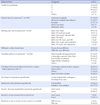Abstract
Purpose
This study was done to examine current status of women's health nursing practicum and identify necessary core nursing skills in this practicum area. Moreover, one syllabus and evaluation sheets for women's health nursing clinical practicum at one university were reviewed.
Methods
A survey design was used with 81 educators who were teaching maternity or women's health nursing and its practicum.
Results
Most clinical sites for practicum were university hospitals (43.0%), women's hospitals (32.7%), or general hospitals (17.3%); but the majority (77.8%) of educators expressed difficulty in finding appropriate practicum places. Common teaching and learning methods were clinical guides for practicum (44.6%), e-learning content (30.2%), and simulation (23.6%). Core nursing skills for this practicum included assessment of stages of labor, preparation of uterine-fetal monitoring devices and interpretation of results, monitoring uterus and fetal activity, and performing Leopold's maneuver. For postpartum care, the following were included; postpartum fundal massage, assessment of breast engorgement, fundus height, and episiotomy sites, inserting urinary catheter, and teaching the use of patient-controlled analgesia.
Summary Statement
▪ What is already known about this topic?
In the area of obstetric nursing practice, nursing students often don't have the opportunity to observe and provide direct nursing care to women who are in labor or having surgery. Nursing faculties have tried various kinds of teaching and learning approaches to overcome the limitation of clinical experiences.
▪ What this paper adds?
Common clinical settings for maternity and women's health nursing practicum were hospitals, but the majority had difficulty finding appropriate clinical settings. Various teaching and learning methods were utilized with clinical guides during practicum, e-learning content, and simulation. Core nursing skills for this practicum were ranked as follows: assessment of stages of labor, postpartum fundal massage, preparation of uterine-fetal monitoring devices, monitoring uterine contractions and fetal activity, and education on massage for breast-feeding.
▪ Implications for practice, education and/or policy
A clear course syllabus, standardized clinical guidebook, core nursing skill contents, and academy-industry cooperation are required to improve the quality of clinical practicum for students in maternity and women's health nursing courses.
References
1. Korean Accreditation Board of Nursing Education. Core basic nursing skill items. 2012. cited 2012 May 1. Available from http://www.kabon.or.kr/HyAdmin/upload/goodFile/120120319112302.pdf.
2. Song J, Kim M. Study on clinical education for nursing in hospitals in Korea. J Korean Acad Soc Nurs Educ. 2013; 19(2):251–264.

3. Lee SO, Eom M, Lee JH. Use of simulation in nursing education. J Korean Acad Soc Nurs Educ. 2007; 13(1):90–94.
4. Kim Y, Chun NM, Lee EH, Cho IS, Ahn S, Kim JI, et al. Student experience and satisfaction with clinical nursing practice in women's health nursing. Korean J Women Health Nurs. 2011; 17(3):225–242.

5. Kim MH. A study of male students experience majoring in nursing. J Korean Acad Soc Nurs Educ. 2004; 10(2):183–193.
6. Chung CW, Kim HS, Park YS. Effects of high-fidelity simulation-based education on maternity nursing. Perspect Nurs Sci. 2011; 8(2):86–96.
7. Park JH, Jung E, Ko JK, Yoo HB. Delivery training for undergraduate medical students using birth simulator. Korean J Obstet Gynecol. 2008; 51(9):950–956.
8. Kim YH, Hwang SY, Lee AY. Perceived confidence in practice of core basic nursing skills of new graduate nurses. J Korean Acad Soc Nurs Educ. 2014; 20(1):37–46.

9. Carlson S, Kotz WJ, Van Rooyen D. Experience of final year nursing students in their preparedness to become registered nurses. Curationis. 2005; 28(4):65–73.

10. Cowin LS, Johnson M, Craven RG, Marsh HW. Causal modeling of self-concept, job satisfaction, and retention of nurses. Int J Nurs Stud. 2008; 45(10):1449–1459.

11. Kim HY, Ko E, Lee ES. Effects of simulation-based education on communication skill and clinical competence in maternity nursing practicum. Korean J Women Health Nurs. 2012; 18(4):312–320.

12. Kim SA, Lee SK, Chae HJ. Effects of clinical practice and simulation-based practice for obstetrical nursing. Korean J Women Health Nurs. 2012; 18(3):180–189.

13. Lee WS, Kim M. Effects and adequacy of high-fidelity simulation-based training for obstetrical nursing. J Korean Acad Nurs. 2011; 41(4):433–443.

14. Korean Accreditation Board of Nursing Education. In : Outcome based curriculum implementation and evaluation. Faculty Workshop; 2013 July 1-2; Daejeon, Korea. Seoul: Author;2013. 06. p. 58.
15. Kim HS. Study on problems and improvement for clinical education in health and nursing department. Seoul: Korean Council for University College Education;2013 Report No.: 2013-8.
16. Cant RP, Cooper SJ. Simulation-based learning in nurse education: Systematic review. J Adv Nurs. 2010; 66(1):3–15.

17. Song YA, Son YJ. Effects of simulation-based practice education for core skill of maternity nursing. Korean Parent Child Health J. 2013; 16(1):37–44.
18. Lee SE. Evaluation of the standardized patients (SP) managed instruction for a clinical maternity nursing course. J Korean Acad Soc Nurs Educ. 2011; 17(1):14–24.




 PDF
PDF ePub
ePub Citation
Citation Print
Print





 XML Download
XML Download